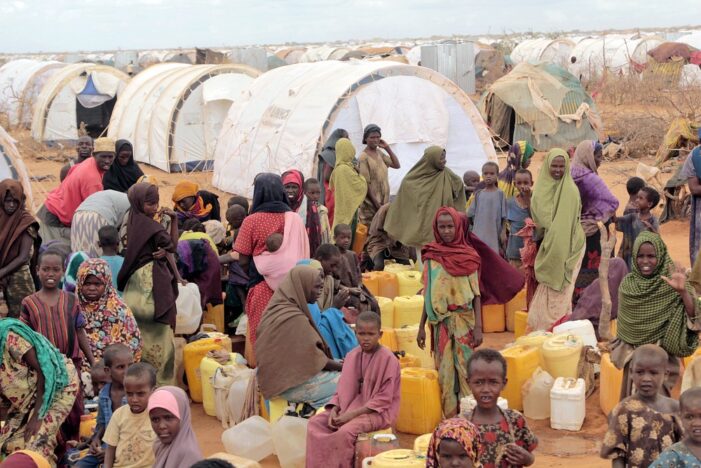Refugee camp, hundreds of thousands of difficult conditions, Somali immigrants are staying. African people waiting to get in the water. August 06, 2011 in Dadaab, Somalia. (Shutterstock)
By Nisar Majid, The Conversation
Somalia is facing a humanitarian crisis of enormous severity and magnitude. This follows four failed rainy seasons, protracted conflict, political instability and the impact of rising global food prices – the latter made significantly worse by the war in Ukraine and the disruption to global food and fuel markets.
There’s a strong possibility of famine being declared later this year and this dire situation is predicted to continue well into next year.
Up to 7.1 million people are considered in need of urgent humanitarian assistance. That’s nearly half of Somalia’s population. The last two famines in Somalia saw roughly 250,000 people die in each. The people that die largely come from marginalized and minority groups in the country. Experts are worried that the death toll this time could meet or even exceed this level.
I’ve studied and highlighted many of the issues with the humanitarian response in Somalia. Judging by discussions I’ve had with experts and observers close to the ground I’m dismayed that, once again, not enough aid is reaching marginalized and minority people within the country, by either Government or aid agencies.
In a report that I’ve put together with colleagues – a mix of academic and humanitarian experts – we reveal that many of the problems that our research team highlighted eight years ago remain today.
In particular, the humanitarian community’s failure to help the most vulnerable groups in southern Somalia remains an unresolved challenge. These groups – who are marginalized because of Somalia’s social hierarchies – suffered the highest levels of mortality in the 1991-1992 and 2011 famines.
Since late last year, in anticipation of a potential famine, my colleagues and I have lobbied humanitarian donors and agencies to focus attention on their exclusion from aid resources. This has taken place through presentations and direct advisories with these agencies.
Many individuals within the “system” are genuinely motivated to find solutions in order to ensure that aid is much more equitably distributed. But the humanitarian sector mirrors broader structural inequalities and power dynamics in Somalia. This reflects vested interests and an acceptance of the status quo in many quarters. It’s a stagnation that must be addressed.
The implications of this situation are that, ultimately, the humanitarian community means little, and brings few benefits, to many groups that it claims to represent and assist – the “most vulnerable”.
Somalia’s neglected groups
All societies have their marginalized and minority groups. These populations typically reflect ethnic or religious identities, racial or caste groups.
Somalia is no different in this respect. It has its own societal hierarchy. There are four main clan families in the country – the Dir, Hawiye, Darod and the Digil and Mirifle.
The Digil and Mirifle are a historically marginalized clan family. The Somali Bantu, are a large minority group, who are not part of the clan system at all.
These two groups are mainly found in the south of the country and are not small minorities. Together they may constitute over 40% of the entire population of Somalia. They comprised the majority of famine victims in both the 1991-1992 and the 2011 famines. They also make up the vast majority of the internally displaced population.
In the latest warnings of famine, the geographic areas identified that are of most concern are exactly those that have seen famine previously. And a recent study found that they have not been sufficiently consulted or reached in emergency assessments. Because of this, we believe that many will not be receiving the cash, food, medical and other interventions they are entitled to.
Increased vulnerability
These marginalized groups are already highly vulnerable to food insecurity and famine because of their structural position in society – they are largely rural and missed out on education and international migration. This has limited their members from obtaining formal employment (including with government and aid organizations), the creation of business communities and the establishment of significant diaspora populations.
This is crucial, as our research on the 2011 famine showed. Families and clans that had members (close or distant) in urban employment, as part of a business community or in the diaspora, were able to call on crucial support through their social networks.
Humanitarian sector failures and struggles
This issue of marginalization and minority exclusion from aid resources has been a regular topic of conversation in humanitarian circles since at least 2014. This followed the release of research, including ours. However, the humanitarian sector in Somalia as a whole has failed to turn these words into significant actions and organizational change.
We’ve seen how, in some instances, humanitarian resources and actors empower certain groups over others. For instance, we found that there are few employees or credible NGOs and institutions from these two groups – the Somali Bantu and the Digil and Mirifle – and where they exist they are likely to be discriminated against in job and resource opportunities. This maintains, or exacerbates, structural inequalities.
Discord, competition and a lack of leadership often characterize the humanitarian sector. It’s beset by a high turnover of staff and, because it’s also so dependent on individuals, struggles to learn from past experience. This makes it hard to develop and maintain an understanding of complex issues and their solutions.
The humanitarian system is currently scaling up – albeit late – in recognition of the scale and severity of the situation, however the incentives inherent in the humanitarian response lean towards scale rather than severity. This means that the easiest people to reach are likely to be prioritized rather than those most at risk of death; it is not easy to reach many of the groups we are most concerned by, whether in camps for internally displaced people or in remote areas under al-Shabaab influence.
There are a number of changes that could address this issue.
Agencies must develop a more strategic approach – and make the organizational changes needed – so that exclusion is addressed as a priority both internally as well as in relation to those they work with. An immediate step that could yield positive results would be to seek out these groups. However, the reality is that these problems are so deeply entrenched it will take years to overcome.
Next, there must be comprehensive research on and with these groups to better understand their predicament and get their input on how to include them in aid practices. Bringing legitimate representatives of these groups into humanitarian circles and discussions will give them a greater voice at the table.
Understanding local power dynamics, including majority-minority tensions, let alone resisting them is not easy but it is incumbent on agencies to invest in doing this better.
Without concerted efforts in this direction the humanitarian sector will continue to neglect and miss its own claimed priority populations.



